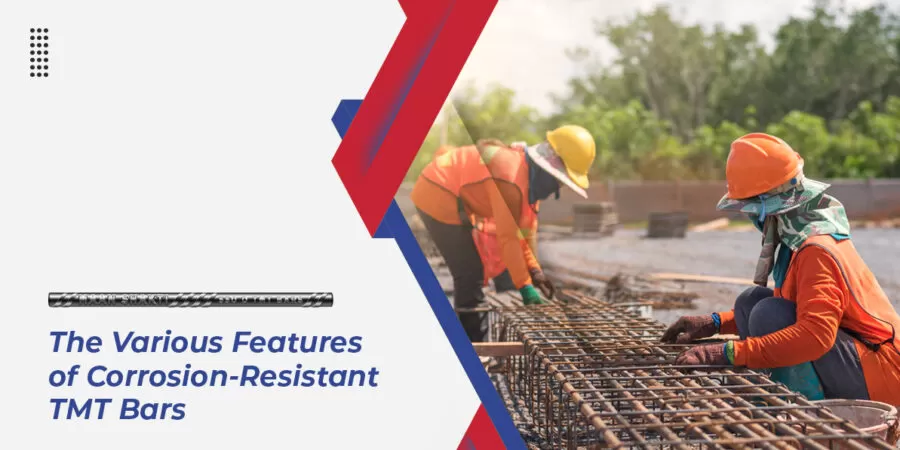Builders and architects always prefer robust materials that promise to last long. These properties help them build robust and reliable structures.
One of the essential building materials is steel bars. These bars glue with the concrete to reinforce it and help the structures last longer.
Ordinary carbon steel bars are not an excellent choice for buildings because they might not withstand the load and pressure of construction for long. The bars might eventually corrode due to constant exposure to moist air and heavy rainfall. Because bars with rust do not gel with the concrete well enough, it might loosen the grip, and the structure’s integrity becomes compromised.
That’s why builders prefer corrosion-resistant TMT bars that offer many advantages besides excellent resistance against corrosion. They are ideal building materials for construction in saline areas or areas with heavy rainfall. As the most popular brand in TMT manufacturing, we have come up with everything about corrosion and how it relates to steel TMT bars.
Corrosion occurs if the TMT bars are exposed to oxygen and moisture. Iron oxidizes smoothly, and corrosion occurs. To prevent this from happening and ensure your structure remains solid and safe, it’s best to use corrosion-resistant TMT bars.
How are Corrosion Resistant TMT Bars Manufactured?
Some specific materials added in a particular ratio make the iron bars resistant to corrosion. A specific proportion of Copper, Chromium, and Phosphorus are added to create strong, reliable, and corrosion-resistant TMT bars. Adding these materials increases the resistance of the steel to corrosion. The Copper added seals the tiny pores of the iron and forms a thin membrane-like film that controls the corrosion.
The way the TMT bars are manufactured also adds to the corrosion resistance. The controlled thermomechanical treatment results in uniform and thick martensitic rims completely free from internal stress. This rim increases the corrosion resistance as well as fatigue strength of the TMT bars.
How Corrosion Happens
Corrosion of concrete-embedded steel happens in three stages:
- Incubation
- Initiation
- Propagation
Corrosion of uncoated steel rebar begins with rust on the bar’s surface, causing cracks near the steel and concrete interface. This initial stage of the onset of corrosion is termed incubation.
This further expands, and the cracks begin to show prominence. This stage is called initiation.
The corrosion products build up over time, resulting in more extensive and accelerated corrosion. This final stage is propagation. This implies very fast de-structuring and finally results in eventually the concrete breaking away and leaving the bar, causing spalling.
Tests for Corrosion Resistance
Several tests need to be carried out to ensure the TMT bar is indeed corrosion-resistant. These tests ensure that the bars produced meet the ASTM standards. Some of the common tests for corrosion resistance are:
Immersion Testing: This is a standard corrosion test carried out in the laboratory. In this test, the weights of dried test specimens are weighed before and after exposure to a corrosive environment for a specific period. After this, the procedure eliminates any corrosion-forming material or organic contaminants. The corrosion resistance of the substance is measured in terms of thickness loss in mils (0.001 inches) per year (mpy) or millimeters per year (mm/yr).
Salt Spray / Fog Testing: A 5% NaCl solution is atomized in a chamber adjusted to a temperature of 35°C. The time for which the samples stand against corrosion is the measure of the test sample’s durability.
Atmosphere Exposure Test: In this test, also known as weathering test, the durability of steel samples is examined by exposing them to UV light and cyclic heating/cooling.
Apart from these, other standard tests to measure the corrosion resistance of steel are the Sulfur di Oxide test and the Potentiodynamic test.
Maan Shakti, one of the most popular brands in TMT manufacturing, passes through all these tests by experts to make sure the end products are of the finest quality.
Features of Corrosion-resistant TMT Bars
As mentioned, TMT bars have several robust features that ensure your construction remains strong and steady for years.
A mixture of alloys
Corrosion-resistant TMT bars are not just iron and steel. Iron and steel tend to form rust as they oxidize in the presence of oxygen in the atmospheric air. So, to create corrosion-resistant TMT bars, some steel plants add chromium, nickel, and other materials in a specific ratio, which makes it resistant to corrosion when added to iron or steel.
High-quality raw materials
Corrosion-resistant TMT bars call for raw materials of high quality. The materials also need to be mixed in a particular ratio or proportion to ensure the strength and anti-corrosive properties of the TMT bars.
Endurance
Corroison-resistant TMT bars resist adverse atmospheric conditions like acidic substances and groundwater salinity. This resistance is not offered by ordinary TMT bars, and they can form rust on exposure to these atmospheric elements.
Longevity
Corrosion-resistant TMT bars last longer than other ordinary TMT bars. Since corrosion does not form on these bars, the grip with the concrete is not affected, and they stay robust and powerful for years. In addition, the bars are flexible and bendable and can thus easily bear the extra load and pressure. The strength, weldability, bendability, and corrosion resistance play a crucial part in the longevity of the bars.
Technologically superior
Creating corrosion-resistant TMT bars requires that you use advanced and sophisticated technology. It also means that the factory in which the TMT bars are manufactured is well-equipped with all the modern amenities which ensure that the TMT bars are technologically superior to other usual TMT bars.
Cost
Although corrosion-resistant TMT bars cost somewhat more than other ordinary TMT bars, as there won’t be much wear and loss of quality throughout their life, it’s a one-time investment. So, corrosion-resistant TMT bars can give you peace of mind for years.
Points to Remember when Choosing Corrosion-resistant TMT Bars
Some factors are essential and should be considered when choosing corrosion-resistant TMT bars.
Trusted manufacturer: The manufacturer of the TMT bars must be authorized and reputed. That way, you can be sure they are using suitable raw materials and technology to create corrosion-resistant TMT bars.
Check for quality: Conduct a quality check regarding strength, durability, materials, rolling mills, manufacturing process, etc. You must carry out this process with the thorough supervision of experts.
Certifications: Check if the TMT bars you buy have the necessary certificates, such as ISI and others.
Grade: Check for suitable TMT bars grades to ensure they are of the correct grade. 550 and 550D are the TMT grades that come with corrosion-resistant properties.
Conclusion
Corrosion resistance is one property that you should look out for in TMT bars. These bars have a lot of advantages over usual TMT bars and should be opted for construction, particularly in regions with high exposure to salinity.
Above, we have mentioned the hows and whys of corrosion and the factors you need to consider when purchasing TMT bars. After learning all the significant advantages that corrosion-resistant TMT bars offer, there’s no reason why you should not opt for them in your construction.


Leave a Reply